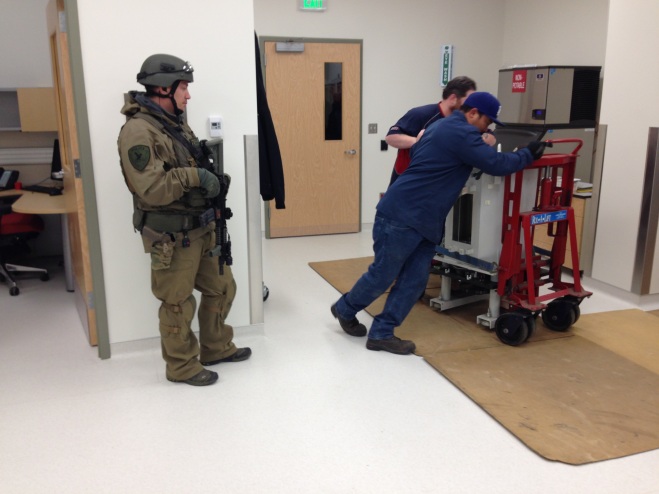Under Cover of Night: An Irradiator Moves 2.5 Miles
Posted by on March 16, 2016
Victor Dricks
Senior Public Affairs Officer
Region IV
On Super Bowl Sunday, while millions of Americans were gathered in front of their television sets, two NRC employees were en route to Anchorage, Alaska, as part of the agency’s mission to ensure the security and safety of irradiators.
Under controlled conditions, large commercial irradiators in the U.S. use gamma rays to kill germs and insects in food products and containers. But the smaller irradiators — about the size of a mini refrigerator — are used in lab settings for sterilizing medical supplies and products. They have their own built-in shielding. Material to be irradiated is placed in a small canister which rotates, exposing the material to radiation. The process leaves no radioactive residue behind, and the devices have been used safely by workers for more than four decades in the United States.
 Because all irradiators contain sealed sources of radioactive
materials that could be of interest to terrorists wanting to make a
“dirty bomb,” the NRC has very rigorous security requirements governing
their use.
Because all irradiators contain sealed sources of radioactive
materials that could be of interest to terrorists wanting to make a
“dirty bomb,” the NRC has very rigorous security requirements governing
their use.
The NRC team was onsite to monitor preparations to move a small irradiator from its existing location to a new facility about 2.5 miles away. But that short trip involved months of planning and tight coordination between the licensed owner, the NRC and local law enforcement agencies.
All irradiator operators must have a license from the NRC or an Agreement State before they can obtain a sealed source containing radioactive materials. Since Alaska is not an Agreement State, their lab-sized, self-shielded irradiator was subject to NRC licensing and oversight.
Before the irradiator was moved, the NRC team conducted a thorough inspection of the new facility to ensure security was adequate and procedures were in place for handling a variety of emergencies. James Thompson, Region IV Senior Health Physicist, and Brooke Smith, an acting branch chief in the Region’s Division of Nuclear Materials & Safety, spent several days reviewing company records and operations, worker training programs and maintenance procedures to ensure compliance with NRC regulations.
Late in the evening on February 10, Anchorage police began cordoning off streets along the route the irradiator would take to its new home. Shortly after 1 a.m., a special truck carrying the irradiator rolled out of a building under the watchful eyes of dozens of local enforcement agents and a SWAT team. The truck had special security features required for the movement of large quantities of radioactive material, per U.S. Department of Transportation requirements.
The tight security, the cover of darkness and the “cloak of secrecy” approach was more than a bit out of the ordinary for the NRC inspectors. But the journey proved uneventful – which was the ending to the story everyone was working toward.
Senior Public Affairs Officer
Region IV
On Super Bowl Sunday, while millions of Americans were gathered in front of their television sets, two NRC employees were en route to Anchorage, Alaska, as part of the agency’s mission to ensure the security and safety of irradiators.
Under controlled conditions, large commercial irradiators in the U.S. use gamma rays to kill germs and insects in food products and containers. But the smaller irradiators — about the size of a mini refrigerator — are used in lab settings for sterilizing medical supplies and products. They have their own built-in shielding. Material to be irradiated is placed in a small canister which rotates, exposing the material to radiation. The process leaves no radioactive residue behind, and the devices have been used safely by workers for more than four decades in the United States.

Moving the small irradiator took a big, coordinated effort.
The NRC team was onsite to monitor preparations to move a small irradiator from its existing location to a new facility about 2.5 miles away. But that short trip involved months of planning and tight coordination between the licensed owner, the NRC and local law enforcement agencies.
All irradiator operators must have a license from the NRC or an Agreement State before they can obtain a sealed source containing radioactive materials. Since Alaska is not an Agreement State, their lab-sized, self-shielded irradiator was subject to NRC licensing and oversight.
Before the irradiator was moved, the NRC team conducted a thorough inspection of the new facility to ensure security was adequate and procedures were in place for handling a variety of emergencies. James Thompson, Region IV Senior Health Physicist, and Brooke Smith, an acting branch chief in the Region’s Division of Nuclear Materials & Safety, spent several days reviewing company records and operations, worker training programs and maintenance procedures to ensure compliance with NRC regulations.
Late in the evening on February 10, Anchorage police began cordoning off streets along the route the irradiator would take to its new home. Shortly after 1 a.m., a special truck carrying the irradiator rolled out of a building under the watchful eyes of dozens of local enforcement agents and a SWAT team. The truck had special security features required for the movement of large quantities of radioactive material, per U.S. Department of Transportation requirements.
The tight security, the cover of darkness and the “cloak of secrecy” approach was more than a bit out of the ordinary for the NRC inspectors. But the journey proved uneventful – which was the ending to the story everyone was working toward.

No comments:
Post a Comment